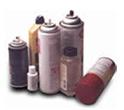Inhalants
 What are Inhalants?
What are Inhalants?
Inhalants are ordinary household products that are inhaled or sniffed by children to get high. There are hundreds of household products on the market today that can be misused as inhalants.
What do they look like?
Examples of products kids abuse to get high include model airplane glue, nail polish remover, cleaning fluids, hair spray, gasoline, the propellant in aerosol whipped cream, spray paint, fabric protector, air conditioner fluid (freon), cooking spray and correction fluid.
How are they used?
These products are sniffed, snorted, bagged (fumes inhaled from a plastic bag), or "huffed" (inhalant-soaked rag, sock, or roll of toilet paper in the mouth) to achieve a high. Inhalants are also sniffed directly from the container.
What are their short-term effects?
Within seconds of inhalation, the user experiences intoxication along with other effects similar to those produced by alcohol. Alcohol-like effects may include slurred speech, an inability to coordinate movements, dizziness, confusion and delirium. Nausea and vomiting are other common side effects. In addition, users may experience lightheadedness, hallucinations, and delusions.
What are their long-term effects?
Compulsive use and a mild withdrawal syndrome can occur with long-term inhalant abuse. Additional symptoms exhibited by long-term inhalant abusers include weight loss, muscle weakness, disorientation, inattentiveness, lack of coordination, irritability, and depression.
After heavy use of inhalants, abusers may feel drowsy for several hours and experience a lingering headache. Because intoxication lasts only a few minutes, abusers frequently seek to prolong their high by continuing to inhale repeatedly over the course of several hours. By doing this, abusers can suffer loss of consciousness and death.
What is their federal classification?
Not Applicable